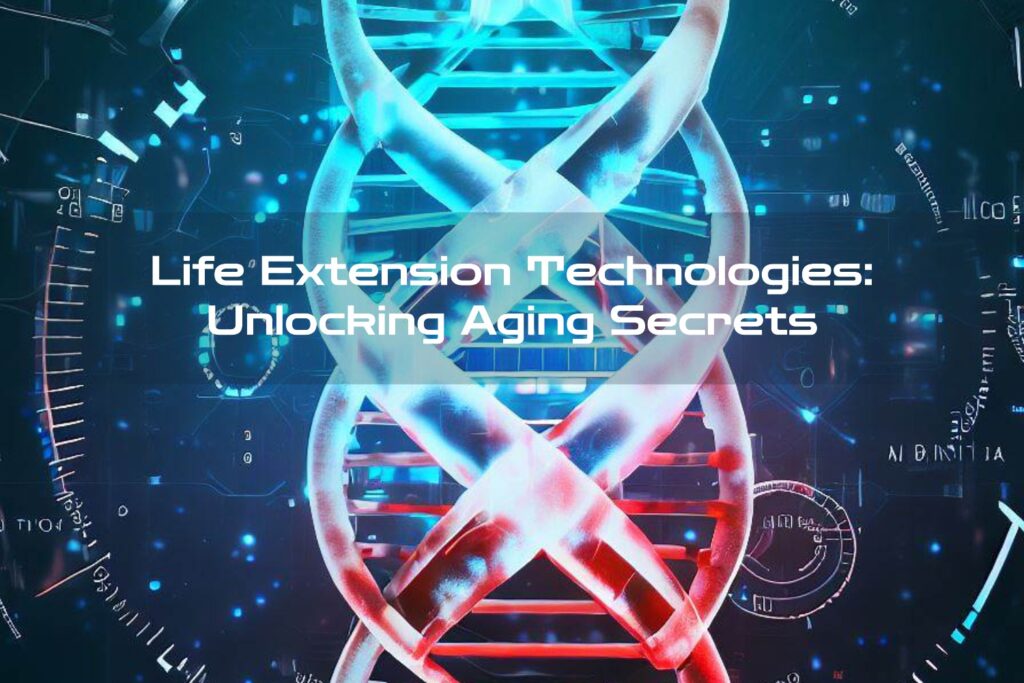Have you ever wished you could live longer, healthier, and happier? Do you fear the inevitable decay of your body and mind as you age?
If so, then you might be interested in life extension technologies. These are scientific methods aimed at slowing down or reversing the biological processes that cause aging.
Definition of life extension technologies
Life extension technologies refer to a collection of methods and techniques designed to extend the human lifespan. This includes various medical interventions, nutritional supplements, lifestyle changes, and other strategies that are intended to slow down or reverse the aging process. The goal is to help people stay healthy and active for as long as possible.
Brief history of the development of life extension technologies

The pursuit of immortality has been a dream for humans since ancient times. However, it wasn’t until the 20th century that serious scientific efforts began to investigate ways to extend the human lifespan. In the early days, many scientists focused on finding ways to slow down or stop the aging process by studying calorie restriction in animals like mice and rats.
Over time, researchers discovered several methods for extending the lifespan of animals such as worms, flies, and rodents. They found that reducing calorie intake led to longer lives in certain species.
Additionally, studies showed how antioxidants can reduce oxidative stress, which contributes greatly to cellular damage caused by aging. Today’s research into life extension technology continues with much success in gene editing therapies such as CRISPR Cas-9 which work towards editing cells so that they are resistant against disease and damage caused by age-related injuries like Parkinson’s Disease or Alzheimer’s Disease.
The Science Behind Aging

Aging is a natural biological process that affects all living organisms. It involves a gradual breakdown of the body’s cells and tissues, leading to various age-related diseases and a decline in overall health.
The primary causes of aging are the accumulation of
- genetic mutations,
- damage to DNA,
- and oxidative stress.
As we age, our cells become less capable of repairing themselves, leading to an increase in cellular damage.
In particular, telomeres (the protective caps at the end of our chromosomes) shorten with each cell division until they can no longer divide at all.
This leads to a decline in organ function and ultimately results in death.
Despite how complex the aging process may seem, researchers have learned that there are certain mechanisms involved that could potentially be targeted by life extension technologies.
For example, studies have shown that reducing caloric intake or practicing intermittent fasting can activate genes associated with longevity. Exercise has also been shown to help prevent age-related diseases and improve overall health.
How Life Extension Technologies Aim to Slow Down or Reverse These Processes
Life extension technologies aim to slow down or reverse the biological processes associated with aging by targeting specific pathways within cells or tissues. Some of these methods include gene editing, stem cell therapy, and senolytics. Gene editing involves changing genes associated with aging through CRISPR technology in order to delay or prevent age-related diseases.
Stem cell therapy involves using stem cells from donors or from one’s own body to replace damaged tissues and organs. Senolytics are drugs that target senescent cells (cells that have stopped dividing), which can contribute to age-related diseases.
While these methods show promising results in animal studies, much more research is needed before they can be safely used on humans for life extension purposes. Nonetheless, innovative scientific research continues on this topic, with some experts believing radical breakthroughs could increase human lifespan beyond what we ever thought was possible.
Current Life Extension Technologies

The Basics: Calorie Restriction and Exercise
Caloric restriction and exercise are two of the most well-known life extension technologies in use today. Caloric restriction involves limiting the amount of calories consumed to a certain daily limit, while still ensuring that all necessary nutrients are obtained. It’s been shown to extend lifespan in various species, from yeast to monkeys, by reducing oxidative stress and inflammation, among other mechanisms.
Additionally, exercise has been shown to improve cardiovascular health, strengthen bones and muscles, and boost mental well-being. Regular exercise has also been linked to an increased lifespan.
Metformin: A Common Diabetes Medication with Anti-Aging Properties
Metformin is a medication commonly used to treat type 2 diabetes. However, recent research suggests that it may have anti-aging properties as well. It works by decreasing glucose production in the liver and increasing insulin sensitivity in peripheral tissues.
Both mechanisms have been linked to extended lifespans in animal studies. Moreover, metformin has also been shown to reduce age-related chronic inflammation – an effect that could potentially slow aging.
NAD+ Boosters: Increasing Cellular Energy Production
Nicotinamide adenine dinucleotide (NAD+) is a coenzyme found in cells that plays an essential role in energy metabolism. Levels of NAD+ decline with age, which may contribute to decreased cellular function and increased disease risk. NAD+ boosters are compounds that increase levels of NAD+.
They include nicotinamide riboside (NR), nicotinamide mononucleotide (NMN), and others. Studies suggest that these compounds can increase cellular energy production and potentially extend lifespans.
Overall, current life extension technologies demonstrate promising results for extending human lifespan through various mechanisms, such as reducing oxidative stress/inflammation or improving energy metabolism. While there is still much research to be done, it’s exciting to see the potential for these technologies to impact human health and longevity.
Emerging Life Extension Technologies

The Promise of Gene Editing
One of the most exciting emerging life extension technologies is gene editing. This technique involves modifying the DNA sequence in a person’s cells to remove disease-causing mutations or increase beneficial traits associated with longevity.
The CRISPR-Cas9 system, which acts like molecular scissors, has revolutionized the field of gene editing and made it easier and more precise than ever before. By using gene editing to increase the expression of genes that promote health and longevity, scientists hope to extend the human lifespan even further.
For example, researchers have found that increasing the expression of a gene called AMPK in mice can improve metabolic function and extend lifespan. Applying this technique to humans may one day become a reality.
However, there are also concerns about the ethical implications of gene editing for life extension purposes. The potential risks and unintended consequences must be carefully considered before any human trials can begin.
Stem Cells: The Fountain of Youth?
Another promising emerging technology for life extension is stem cell therapy. Stem cells are cells that have not yet differentiated into specific types of cells but have the ability to develop into many different types of tissues in the body. By using stem cell therapy, researchers hope to regenerate damaged tissues or organs associated with aging.
Stem cells hold promise for treating everything from Alzheimer’s disease to heart failure, but they may also be used as an anti-aging treatment by replenishing lost or damaged tissue due to aging. For example, researchers have managed to reverse cellular aging markers in elderly mice by transplanting embryonic stem cells into their bone marrow.
While stem cell therapy shows a lot of potential for an extended lifespan and improved healthspan, there are still many safety concerns associated with it. Additionally, ethical debates about using embryonic stem cells remain unresolved.
The Future is Bright
As we continue to discover and refine emerging life extension technologies, the possibility of a radical breakthrough in extending the human lifespan becomes more and more likely. While the current methods of life extension through diet and exercise are certainly effective, they are limited in their ability to truly extend lifespans.
As we move forward into this era of rapidly advancing technology, it’s important that we approach these developments with careful consideration for both their potential benefits and potential risks. Only by doing so can we ensure that the future is indeed bright for those seeking to push the boundaries of aging through innovative new technologies like gene editing and stem cell therapy.
The Controversies Surrounding Life Extension Technologies

The Ethics of Extending Life
Extending human life beyond its natural limitations is a topic that raises many ethical concerns and debates. Some argue that it is morally wrong to try to play God and extend our lifespans, while others see it as the ultimate goal of medicine.
One concern is that life extension technologies would only be available to the wealthy, creating a further divide between the rich and poor. Critics also argue that these technologies could put a strain on resources and that we should instead focus on improving the quality of life for those who are already alive.
However, proponents of life extension technologies argue that they could help solve major problems such as overpopulation by allowing us to spread out our lives more evenly over time. They also claim that advances in technology have always led to controversy in their early days but have ultimately led to great progress and benefits for humanity.
Debate Over Whether Extending Lifespan is Desirable
Another debate surrounding life extension technologies is whether or not extending our lifespan is something we want to do. Some argue that death gives meaning to life, while others see it as a tragedy. Those against extending our lifespan often point out the potential negative consequences, such as boredom or a lack of purpose, if we lived much longer than expected.
They may also argue that death gives us a sense of urgency and motivates us to make the most of our time. On the other hand, those in favor of extending our lifespan argue that it would give us more time to achieve our goals and contribute positively to society.
They may also point out how much suffering could be avoided if we were able to extend healthy lifespans. While there are valid concerns surrounding life extension technologies, there are also compelling arguments for why they should be pursued.
As with any new technology or scientific discovery, there will always be controversy and debate over its implications. Ultimately, it is up to individuals and society as a whole to make decisions about what is right and what is desirable when it comes to extending human life.
The Future of Life Extension Technologies

Pushing Beyond Limits: Speculating on What the Future Holds for Life Extension Technologies
As technology continues to progress, it’s not hard to imagine that we will continue to find ways to extend the human lifespan. In fact, there are already several new technologies in development that could potentially revolutionize the way we think about aging and mortality. One such technology is CRISPR-Cas9 gene editing, which has the potential to allow scientists to directly edit the DNA of organisms – including humans – in order to eliminate genetic diseases and perhaps even extend lifespan.
Another promising area of research is in the development of senolytics, drugs that specifically target and destroy senescent cells – cells that have stopped dividing but continue to produce toxins that contribute to aging. By eliminating these cells, researchers believe they could significantly extend lifespans and prevent many age-related diseases such as Alzheimer’s and heart disease.
But perhaps one of the most exciting areas of research today is in the field of artificial intelligence (AI). As machines continue to learn and adapt at an exponential rate, it’s not hard to envision a future where AI could be used to develop personalized strategies for extending a person’s lifespan based on a person’s genetics, lifestyle factors, and medical history.
Raising the Bar: The Possibility for Radical Breakthroughs in Extending Human Lifespan
While some may argue that extending the human lifespan beyond 100 years is both unnecessary and unethical, others believe that there is no limit to what science can achieve when it comes to pushing the boundaries of aging. In fact, some researchers are actively working towards radical breakthroughs that would allow humans to live not only longer but also healthier lives.
One such researcher is Dr. Aubrey de Grey, who believes that aging itself can be treated as a disease rather than an inevitable process. His theory proposes a combination of genetic therapies, stem cell treatments, and other interventions to repair the damage that accumulates in our cells over time.
If successful, this approach could potentially allow humans to live indefinitely. Of course, such a radical breakthrough is still far off – if it’s even possible at all.
But as the field of life extension continues to grow and evolve, it’s clear that we are only scratching the surface of what science can achieve when it comes to pushing beyond the limits of aging. Whether we will one day live for centuries or even millennia remains to be seen – but one thing is certain: the future of life extension technologies is full of promise and potential.
Final Thoughts

Throughout this article, we have explored the world of life extension technologies – what they are, how they work, and what their potential impact could be. We have learned that aging is a complex biological process that is not fully understood, but that scientists and researchers are working tirelessly to develop new ways to slow it down or even reverse it. Some methods, such as calorie restriction and exercise, have already been shown to extend lifespans in animal models and may even work in humans.
As we move forward into the 21st century, we can expect more breakthroughs in life extension technologies. Emerging methods such as gene editing and stem cell therapy hold great promise for extending the human lifespan even further.
However, these technologies also raise ethical concerns about the implications of extended lifespans on society and individual lives. While there are still many questions left unanswered about aging and life extension technologies – one thing is certain: the potential impact of these methods cannot be ignored.
As scientists continue to push the boundaries of aging research, we may one day live in a world where disease is eradicated and our lifespans are extended beyond what was once thought possible. The possibilities are endless – and with continued research and investment into these fields – perhaps one day they will become a reality.
FAQ: Life Extension Technologies
1. What are life extension technologies?
– Life extension technologies refer to scientific advancements and interventions aimed at extending human lifespan and improving overall health and well-being.
2. How do life extension technologies work?
– Life extension technologies utilize various approaches, including biomedical interventions, genetic engineering, regenerative medicine, and lifestyle modifications, to target the underlying causes of aging and age-related diseases. These technologies aim to slow down the aging process and enhance longevity.
3. Are life extension technologies safe?
– Safety is a primary concern when it comes to life extension technologies. While many of these technologies are still in the experimental or early stages of development, rigorous testing and research are conducted to ensure their safety and effectiveness. It’s important to note that the field of life extension is constantly evolving, and new discoveries and improvements are made over time.
4. What are some examples of life extension technologies?
– There are several examples of life extension technologies, including:
– Telomere extension: Telomeres, which are protective caps at the end of chromosomes, play a crucial role in cellular aging. Telomere extension technologies aim to lengthen telomeres, potentially slowing down the aging process.
– Senolytics: Senescent cells, which accumulate with age, can contribute to age-related diseases. Senolytics are drugs or interventions designed to remove or rejuvenate these senescent cells, promoting healthier aging.
– Caloric restriction mimetics: Caloric restriction has been shown to extend lifespan in various organisms. Caloric restriction mimetics are compounds that mimic the effects of calorie restriction, potentially providing similar benefits without the need for extreme dietary changes.
– Gene therapy: Gene therapies can target specific genes or genetic factors associated with aging or age-related diseases. By modifying these genes, researchers aim to enhance healthspan and lifespan.
– Anti-aging drugs: Pharmaceutical companies are actively developing drugs that target aging processes, such as inflammation, oxidative stress, and mitochondrial dysfunction, with the goal of extending human lifespan.
5. Can life extension technologies reverse the aging process?
– While life extension technologies have shown promise in slowing down the aging process and improving healthspan, it is important to note that complete reversal of aging has not yet been achieved. However, ongoing research and advancements in the field are continuously expanding our understanding of the aging process and the potential for interventions to mitigate its effects.
6. Are life extension technologies only for the wealthy?
– The accessibility of life extension technologies is a valid concern. While some interventions may currently be costly or available only to a select few, as the field progresses, there is a growing emphasis on making these technologies more affordable and accessible to a broader population. Additionally, public awareness, advocacy, and policy efforts can play a significant role in promoting equitable access to life extension technologies.
7. Are there any ethical considerations associated with life extension technologies?
– The development and application of life extension technologies raise important ethical considerations. Some of the key concerns include the equitable distribution of these technologies, potential disparities in access, unintended consequences, and the impact on society as a whole. Ethical discussions and frameworks are crucial for navigating these complex issues and ensuring responsible development and implementation of life extension technologies.
8. Can life extension technologies guarantee a longer life?
– Life extension technologies cannot guarantee a longer life with absolute certainty. While these technologies aim to improve health and longevity, individual factors such as genetics, lifestyle choices, and environmental influences also play significant roles in determining lifespan. Life extension technologies should be seen as tools to enhance overall health and potentially extend lifespan, rather than absolute guarantees of immortality.
9. Are there any lifestyle changes that can complement life extension technologies?
– Yes, lifestyle changes can complement life extension technologies and enhance their effectiveness. Adopting a healthy diet, engaging in regular physical activity, managing stress, getting sufficient sleep, and avoiding harmful habits such as smoking and excessive alcohol consumption are all essential for maintaining optimal health and potentially extending lifespan. Integrating these lifestyle changes alongside life extension technologies can have a synergistic effect on overall well-being.
10. Where can I learn more about life extension technologies?
– To learn more about life extension technologies, you can explore reputable scientific journals, attend conferences and seminars focused on longevity and aging research, and consult with experts in the field. Additionally, there are online resources, books, and documentaries that provide valuable insights into the latest developments and advancements in life extension technologies. It’s important to rely on credible sources to stay informed and make well-informed decisions regarding your health and well-being.
Remember, the field of life extension technologies is rapidly evolving, and it is always recommended to consult with healthcare professionals and experts in the field for personalized guidance and advice.
TL;DR…
– 🧬 Life extension technologies aim to unlock the secrets of aging and push beyond the boundaries of human lifespan.
– 📜 The definition of life extension technologies encompasses scientific advancements targeting aging processes and promoting longevity.
– ⏳ The development of life extension technologies has a brief history, with ongoing progress and discoveries shaping the field.
– 🔬 Life extension technologies are based on the scientific understanding of aging processes and how to slow them down or potentially reverse them.
– 🥦 Calorie restriction and exercise are fundamental components of life extension techniques, promoting health and longevity.
– 💊 Metformin, a diabetes medication, has shown anti-aging properties and is being investigated as a potential life extension intervention.
– ⚡️ NAD+ boosters are being explored to increase cellular energy production and potentially slow down aging.
– 🔬 Gene editing holds promise as a future life extension technology, allowing targeted modifications to genes associated with aging.
– 🧪 Stem cells are being researched for their potential to rejuvenate tissues and organs, contributing to extended lifespan.
– 🌅 The future of life extension technologies looks promising, with ongoing advancements and breakthroughs on the horizon.
– ⚖️ Ethical considerations are crucial when discussing life extension technologies, including equitable access and societal impacts.
– 💭 There is debate surrounding whether extending lifespan is desirable, raising important philosophical and ethical questions.
– 🚀 Speculation on the future of life extension technologies suggests the potential for radical breakthroughs and extended human lifespans.
– 💡 The final thoughts emphasize the need for responsible development and research, along with consulting experts in the field for personalized guidance.

C M, a seasoned editor, journalist, and consultant, is deeply fascinated by the convergence of technology, space, and the future of humanity.
With a particular interest in transhumanism, futurology, and the philosophical and ethical dimensions of these domains, C M serves as the lead contributor to TranscendSphere and SpaceSpotlight.
When not penning insightful articles on these rapidly evolving fields, C M indulges in their love for podcasts and books, proudly embracing their status as a ‘Happy Nerd Extraordinaire!’





